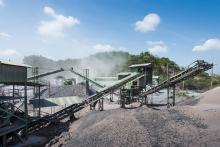The debate continues to rage on the best way to benchmark the cement industry for phase three of the EU Emissions Trading System. Robert Camp looks at the arguments
When the EU Emissions Trading System (ETS) was first introduced in 2005, most of the emission allowances were handed out for free, based on historic emissions. The basic idea is that as the ETS matures, the proportion of free allowances will decrease while an increasing number will be auctioned. This gives producers an incentive to reduce emissions and make their processes as efficient as possible.
The third phase of the ETS, which runs from 2013 to 2020, was agreed in December 2008 as part of the wider EU 2020 Climate & Energy Package. It was revised significantly to be more environmentally ambitious and to keep the EU on track to cut emissions by 60 to 80% by 2050. For phase three, the ETS is meant to deliver more emissions reductions, more predictable market conditions and more certainty for industry.
And that's where benchmarking comes in because free allocation of allowances will continue to play a significant role, especially for industrial activities, at least until 2020. But a system based on historic emissions actually rewards those who have polluted most. In order for the ETS to work more effectively, the Commission wants to ensure that free allocations benefit the most efficient producers.
One way to do that is to allocate emissions allowances based on a product-specific benchmark per unit of production. The benchmark is set so that the most efficient operators receive the maximum number of allowances. Other operators must improve their efficiency to the benchmark level, or pay for more allowances if improvements are not possible.
In this way the most efficient processes and technologies set the yardstick for others and this - at least in theory - creates a system of allowances for industrial emitters that is fair and transparent.
Fair system
But when it comes to the cement industry, what do you benchmark, and how can you apply that benchmark across a sector of industry that varies greatly in the efficiency of processes used? That was the question posed by the
Adopting an EU-wide clinker benchmark has the support of some 95% of the European cement industry, including European trade body
There is still a minority that remains strongly opposed and advocates a cement benchmark instead. They argue that clinker benchmarking distributes more allowances to installations with high carbon dioxide emissions. As a consequence, the opponents say, the effort to comply with a further reduction of the allowances will be much more difficult to achieve for those companies that have already taken action.
Furthermore, opponents to clinker benchmarking argue that reduction of the clinker content of cement is the single most cost effective option for reducing emissions, and setting a cement benchmark in Europe would support efforts for an international sectoral agreement on emissions and help engage the industry in emerging and developing economies.
But clinker proponents argue that cement benchmarking would be over-complicated because it would have to account for the differentiated availability of clinker substitutes and quality differences between blended cements. They add that cement benchmarking cannot be applied to individual installations because of clinker trade between them, including those with grinding stations, and conclude that clinker benchmarking remains the most practical approach.
Finding compromise
The Commission has been left to pick its way through these diverging arguments, but a compromise is emerging.
At the March meeting of the Commission's technical working group, which is examining benchmarking for the ETS across a range of sectors, the main ideas of the so-called 'compromise solution' were presented.
According to the minutes of that meeting, clinker production will remain the base for the allocation; but a bonus-malus system for integrated clinker/cement plants would allow for modifications to the allocation, based on a share of the clinker to cement ratio.
The minutes also show that two member states at the meeting supported a single clinker benchmark to avoid market distortions, while another argued in favour of a compromise. So it would appear that the industry and member states remain divided on the best way forward. And what is clear is that discussions around this complex issue still have some way to go before agreement is reached on the best way to bring the cement industry into phase three of the ETS.









